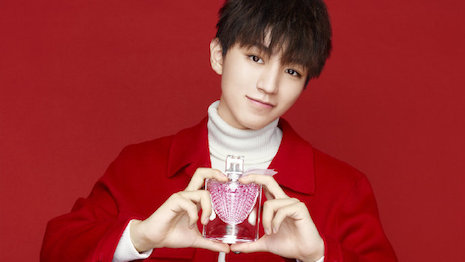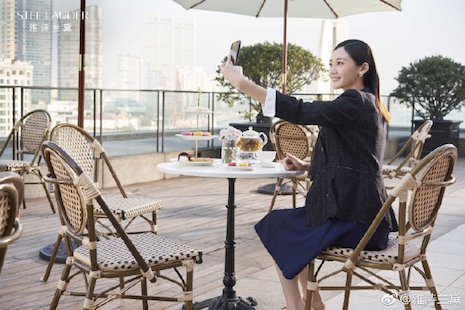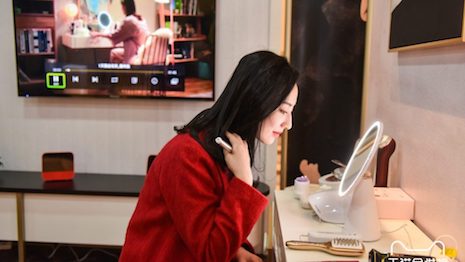While blockbuster beauty brands have strong awareness and trust in the Chinese market, consumers are increasingly interested in trying lesser-known labels.
According to a new report from Reuter: Intelligence, 85 percent of women and 70 percent of Chinese men are curious about niche brands, and 92 percent of male beauty buyers say they prefer indie options. These brands are a growing competition for bigger labels, as consumers believe niche products put more investment into developing formulas than marketing.
"This is almost evidence of the claim that Chinese luxury consumers are discerning and ultra-knowledgeable about luxury," said Lee Folland, research director of Reuter: Intelligence, Shanghai. "They already know all about the well-established brands and are searching for ‘newness’ and for the non-mainstream, bold and expressive traits of niche brands.
"This is what we’re seeing in China in all categories, whether travel, fashion or beauty," he said. "For the ‘big brands’, firstly these are large groups that either own or have invested into niche brands already.
"The trend for niche does not mean that consumers do not also own the big brands too, but it points to a search for fresh, bold and more specialized product segmentation."
Reuter: Intelligence's report is based on an online survey of about 300 consumers in Tier 1 cities who frequently purchase beauty products. The agency also conducted focus groups and studies for qualitative information.
Under the radar
Female consumers are still more apt to show a preference for big brands, with 69 percent saying they would rather have a more well known brand. They feel these labels are more trustworthy and have better packaging, technology and science behind them.
Comparatively, men say they prefer niche brands. They are also more apt to say that niche labels’ packagings are superior and that they reflect their style.
Across male and female consumers, beauty buyers say they purchase bigger brands more frequently and would pay more for them.
 Big brands such as Lancôme are still popular. Image credit: Lancôme
Big brands such as Lancôme are still popular. Image credit: Lancôme
Eighty-four percent of men and 77 percent of women would also pay more for organic beauty.
"The market for male beauty is growing even more quickly than the female beauty market, according to various sources from Alibaba to Euromonitor," Mr. Folland said. "While gender neutrality, male beauty influencers and such are not at all unique to China, the culture is unique in terms of men’s interest and willingness to use beauty products, such as BB cream, concealer, mascara and lipstick.
"The curiosity is also from a much wider male demographic in China, versus what a brand could expect to see in the West, for example," he said. "Brands seem to be still catching up with the trend, however.
"Some estimate that less than half of international prestige beauty brands have male products available in China. So, while the demand is there, male consumers have very limited choice, which is a missed opportunity."
Friends and key opinion leaders are Chinese consumers’ top channels of discovery when it comes to beauty buys. Word of mouth is even more crucial for more under-the-radar labels, which might not have as many reviews or as extensive of a digital presence.
Brands also need to be thinking beyond Weibo and WeChat. In its few short years of existence, Red Book has become a key platform for influencer content.
Aside from KOLs and their social circle, consumers are conducting a lot of their research on ecommerce sites and online media, such as magazines’ digital editions.
While KOLs might point consumers to a particular product, only 17 percent of male consumers and 6 percent of women said that they heavily weigh what influencers post when making a purchase.

Influencers and friends introduce many consumers to new makeup. Image credit: Estée Lauder
Advertising also does not impact consumers as much, with 17 percent of men and 4 percent of women saying that ads are important.
Even though Chinese consumers are heavily engaging and shopping on digital channels, they still value the bricks-and-mortar experience for beauty buying.
The majority of consumers agree that physical stores enable them to try on products before buying. They also say that authenticity is guaranteed on in-store purchases.
"China is a leader in the digital world that physical retail has surged back," Mr. Folland said. "O2O functionality and consumer understanding and uptake of this is exceptionally powerful in China.
"Chinese consumers now expect a digitally enabled playground where they can instantly ‘check in’ using their WeChat and the in-store experience is personalized to their profile, with diverse and holistic online-offline functionality.
"This is not limited to cosmetics, yet certain digital features lend themselves ideally to it, such as AI mirrors, VR product trialing and the wide range of products that can be trialled in-store, i.e. touched and felt."
China centric
In addition to niche beauty, local products are finding an audience with Chinese buyers.
As the Chinese government and retailers push customers to buy from local brands, C-beauty is on the rise, according to research from Gartner L2.
Chinese beauty labels are leveraging national pride in their marketing, helping them gain traction with consumers, particularly around cultural holidays such as Lunar New Year. Following the wave of K-beauty and J-beauty brands from South Korea and Japan, C-beauty is finding an audience, particularly in digital channels such as Alibaba’s Tmall (see story).
Luxury brands are also stepping up their engagement tactics on Chinese social media and shopping platforms.
France’s YSL Beauty used a Coachella pop-up to engage with Chinese consumers, creating a cross-continent push around the music festival.
For the first weekend of Coachella, YSL Beauty staged a gas station-themed activation in Palm Springs, complete with a live-streamed party featuring performances by Chinese musicians. While Coachella is often about reaching a local audience, YSL Beauty decided to use the event as a push for its Super Brand Day on April 23, driving attention for its sale (see story).
"Both brands and consumers are well aware that the KOL world is flooded with influencers claiming huge numbers," Mr. Folland said. "The point is that brands need to get away from numbers and reach and query why that KOL has become successful and built a community.
"What have they achieved, where and when did they rise to fame? Was it via a TV show, are they a designer or creative person, for what reason are they legitimately followed?" he said. "Numbers won’t tell this story, but the background and knowledge of the influencer will. Do they only pose, or do they have real insight and detailed guidance given to their followers?
"Authenticity is a word thrown around a lot nowadays, but for a good reason. Chinese consumers are sophisticated and simply won’t engage with blatant ad-style KOL collaborations. It’s important to curate influencer partners with care and ensure content is real."
{"ct":"C9mU0lbU1ELqzuyLH\/DUcQsR26F4J3ONWkfoFNelWADf2g\/4Zz+Bovs4TXUSJCNnhfm4TM8Fe0Xr4fQd1VE\/P+51XAEpl8yDS8pabRLnaq\/gvKnUI7q0sXkSVVUc1IOz6PsS3dlqsJFoaDyCgjrdkrmf1Rfrcr7IJuOb2eyXjgMkOoCqTip0v\/gmM8w4Vd9AirKLG+pse0xEAWnzMz2zObPrUl6FKkUoV+sQtOK3yodlFnvwrjFADO5DF0lCcqcHnVSycpghAJgpxKWurh\/ytXNiOvc9xfVNNh5jlQwoFJnAEIl+UmK0jGlnq5eHIzDDaiZYBhKY8jEGlYQdFyg4O2O0NE8DAobWrRkfGwdWWn7ycqHp+3qiN2eBOL4kmI80EBaSLB6fJYI01jSkI12QrANGQdgZRUbmJm2jiJM\/OsTghaQz0gF9pJcf1OlfvC+AM7bNmq2F2Mb94oX6hzvIlSqQyVQHY5KiuBIqGJNelZiNSBO+YXLDTjFpvG4QjdYpq+SkAzvb49l9UHd2d9paZrKi5Nf5poNfi6A6yPceo9vIeIu5oRHP5xToIAKk3JjJQ74N8CbBSaG7Zz\/LY9280JapASXDyFU6OxARo3INlU1hL0BHjiOv92dVjfM\/sYUws\/j3wKA23yZ0DZsDrkXB7RonP7VWeXZYpgvWLO3a2zzJ86G\/QSNSNaCDr5nvVX4XWO83eQ7acnDzW0YV7+3UB+DrGRXsg1lXcua8WUJZDlIASU9Ivty7q7vBlwlEFlXqXwI1iTCcxyTkheYf69b4dUwoZ8sg56RHv2G8BD04639nMunAKaR7IUq0toiRjQy5X3OhBBFfo3SPvi8h2W1Rj64sHKov7+F122MqwwW8vxOgyVDi51mqXQnyOVfy0\/5J0Ta4BGoGLE2ulEFRBjtZyLAW+bmdAZC1Kx\/a7qGu0omuy3upIq+AVprMSxvuCeUZnTCLIba1ylgIxnDpvv46aMKgz8xnj0RK8RO9MrBFzCmTCQEDFd+Beu9FcnxzNR6qS0YxQ0YGoqovQGe569PC7ePHDOglHKJE5fyRxjhwNWAPGA6cOGSERC65jzbIhAXoArYjmrLkak77SB15WAB+jOB8TKStEdXxsqBLrtbHZiaLRxAX5xqiYoc3a86mJMpPp3EBbUzn3kqYbpSCB0SuSw027NOKfdArASMmJiGPvWREYF1b\/21U8MsOkj45ygxIXRJ3FiBRiZBtT02AInwU9zKuylbuw9k58UqOvQT5iQ9xXBFBlJ6nWXZ975KrYO5oRiRUZbo+p1xga86qJbMB\/nKQXru35Gk4WaK\/Azfo\/iHBsznhT7fvHSWUPoUb9OVWrsNGh3fp4SwBfto2O70hzQXrELUYEBCJV3Bta7uUdhH1YVdfjmq+mB3ZMMXf8IpJAiiOh9+WkPqd2pVH7fyusw7Ng1r1Vdd\/bzvUxQa\/xqrWpo6YXn+NNqBU7m7XhwuDF3hryaEOptA0MMlFoPpaLQ37vljLE8JBdnGCCKlTeCgW3lueLGGTgMvNv5OMWH8PC9tbtYYb0Kze6SQaEVxIGr+vWjobTVyCuUeyEzw5AXDBq1AKBCJeO\/rM3LE0pNMnq8sXtU733zlGV1PFE4ZLWtz9GLsfnlE2xIUT5FBnDR6ibj352HjJNY9Yj4aIGFMyqi47jPZ1fFCPUbSiUuTIsrBNYLUKrlL4CiQ\/RGodX\/\/dPrvnTkpTyX953QjgJWNHOzpfGcR3fojElcKXkF3Y1qhj4kYBpISL6J9BpsSjun6FsE8m2dwKqY143NOp9KPm\/Ua\/frwvTgYFjYPj17yjyq5r0S4QthUYdXyEGyKrwr2K9bVwaWywTQBMGQSe6q8Mfd\/A0Tv0KyWeNgXzldgbjIGU+PXr0k+iiQfyOkMxHWeM7zpX8bmC\/18Xf8\/rYIbXB8lu9SibPMqIqv6\/PgSrmhSI6EsjoIOAWcUOROmmbvb7oPEKN99KTvOtOkCruuXTwONj+XzIhHmiMAV3Id5HwfW43lwvYWXXKpNTMJ+3IOKjtliPSBbE3COcxWnBJwWSvpyrZ3ny3RadcuqcImUGm\/0n5dvAsmYC6a9h6gNT\/cLJ7kwPwd+KIs2\/2HBUi9alZfowFkQGQj3ZTkZSL54sUqGGePno4u21XC\/2eZYRspkcI\/O4Lrz+DxPBWa4f\/Ye5gMP+O+AfzTDwV+7xEelLG\/VdVGnzO5\/9tf0fkEixXXfROHUv7F\/o6H3xhAIhxyhbDvpQWX4kYZUqSc5kWsCxUDJEJKDC35kGMWjBJgo942K0uSZylx7ravvYIID7ASmaGrRM6Y1o3kzzJAr9mjxXO7x+GTylfZvGkEuKWKidgcyVqlPOdcXE5BamJ4vyixBcMEDHIy0DL4hs0Z7y+\/d+2Q\/2xc1mN5dnCNHWdvg9yp\/g8Rb5PVvoph4TNruX9zwLIxftLnE3LjMwnxguVEXCd6ZidnBn3dhF9JjWEgJPpU5MbMy6H5hKz6L8o\/PgKgDe5+jH5Q1+iC1nMQOR+OieLgk3QRa8kH7Tsfcxozxz+dOizuxATFAMIStt15ddgf3HvXY\/DWez2HY\/Pjei\/SyLozkIvJj7ETxSEJTp6dvsJlnUgsmMAjPCBZHYUoXxbO1H60bU+msMdd5xv6ymK7ZOBIdc+iOmJxsGxOY19+6JyQxVWWZ8ILRNfyI87IqEzPi8F3p7ojyi2VPa33CQyBB1HPvxq\/F4a4+8L6IIOa0hjSdW1lQZ627Rae\/gWqMMLcrxvsu6yr0IX4nBTAcSTciC51q\/e9IQ+zk\/xOw4gdMg\/4tqME6\/bDHn4UoZhFeTbq9P2gERtXzsGi1flcVs2RYMSN5etXgawDVjAhtN6XrHF1zapJxP4PkNsDpD4FRa0glJBeBBv7UjZVXyGK3DbsutQD1GkshDgUnoFfJGDdtMczu\/sHHsEZowVzu6aSX5VMDsXUHNKOkqe2MRsAXTrHII8nDsPvtQPuvGT5Dz8I5vQz2Cbq\/Acu5LHHHPbdE59fvWfGF25B3KMgE1AOLjZuJiV033QRkKKruHXzFrQCEG9h520PyeC6SrdRGHf4L8aFbYjzHe3Cnj8c72SpHiK1bOu5PuhiY9uWApU5oAYI6mWSeclztd2jxie5BTWEXnd7vBiSOEG0AROj58UJ\/f1xNCbubCBapd5bFjIYYiovWdFozsTJfaTupwdVFkE0LfmhFhPjBrCTTXL8QirLxhrS+DmOuAvIiNmNNWSYKkof\/jy4WPvEy3mR6x3v3Dvht5dr2IwZ\/5bOEze+OXD6kM5HlXFqCdzr0d0whFmzGCWOGevJwYDywwe5dvJa78UywE9fyB7lV0G49L9tbUOt8YydyiBEqR4yXSRt0PoCxq5Ke+ybZNyHZKN2CX\/Nd\/2hBGmQEyC4NgT3QCY\/6SOPuGoRI8csORKw6VDabNEccmp3VbdM1sK7GPXCQvJuap4qIX81ZzBbt0RhzMfwqy2bEmZgls5QRpyRRKsyl4E72UO73LqB1JQkbwtTewjNthsXnCyAfR+kT9tipl6kOhdFnPao\/3tlELazAaiZTO+ILKNSUvyVe+2uq2vgHDNYKoov6kfFCggxy5K\/viG\/NFUxxaBmrfqvaGkSoVRWHvwpXu+3VIX+cPsqTYQcIhEMgBNGDJZLpvb1XdNSOq3iYghk2nCX\/gaoHkj01zAXWkpeGxcpSGPxg4P92D\/YustAmZo71pFLpyfx39K6TdDQaS6GT3SM2H8QBm5FfGK0XLLbcslDbkS48sLzsRfP+tUTC3pNQfzE+EPqX+Dmrs\/9D9Qyo59hLeOwLdpJvhpxt8mhUc9ZEXf6hYSStHJP6XsTQhZBRDmUcAZQh\/baurBVHRXOXF\/69J+mMxtYfaBpphK6WFv9uNoCTsil7+h9QRDwyAVQMgnwWl6ce5EvBqIdiNJsqzHXnsboNppy3MmLsxCwokz4+qR0ruDxW0uuKrudic2zDBknWRYx3VmTk2vN8PJ6CXxdhZZ+RCsIbOvmrksZ22e5803Iik45K4i0w\/aj+zd74lsyN8bsntTN1ZsZacxeWic9iA\/82RX3vPWBJkGyf5F3Z8xxWiXFLgALTxy8Bng54ckOYwezvPxSmCgByXaDQ2BS2+6r2Xge6JZjPiIfSnBb669CXFmB3Aje6L\/kSsHf4rK+UG9TO3oKMz1lypIp466E9vF9DopGdfSdIHd0\/r1qvjU0TKkULqpeecZHe\/LuSM3XmmgUhZuDveNRWzNPh6OUquwxztagy51roYhLGHqy5z\/Rkg05wX+3ftfRvY15HLklLfVWGB77t9FGXV9GhDsPDjueG7ygHbss5Q8efG8zXBKzSfPiqJtEYsT+i8RL+V\/+L4g91h9sXJT\/A8l6nt6J0KMyxbeP5deIZB+k6G04LsM3lIJdw4aw7FAp+ps+PGJne0MBoy3jrFFiO46LGDUW2vRDlw9QAtB7jB2kcxCQ8xLkImqhFAhiGFgADDMM+RIQQ8vkgzAhuON6h3LjUHzqrf18DNJlG2aqZyDSjiO\/TS5fzjmvqoRuLLgz5rVpvzIV6aENq3PwbL4TDSD1YIv7eXWJj\/qGrwrRBL7bWwKBC8FLDoo6KTBiMMTwrVdHzeV9fvsuOnx17pGmIzrOFwZGdxxQu8\/Q4Q83twfQr0ft5xavCoiRBvPheJoZ6mQjQ2XFXNj8lJIcN2R8Op+ocZcHAFjcCmeu++\/2\/uRS7iRWPGzG8JjarYFBWOkcGYr+WO075JIL5u2I3CqwQFNZSdVEHZQ2HY4HWguEb2g0m7U6azPeaqhGoOoMIe8NRhsqyE129B7dCdm\/huqmiZ2DSJvT3JpE+7FGo4GzEFPiN3zIaL\/qSR99B1XOc0BfSkkH34jCN\/M7TUIAZujgCa\/ML9yDDEvpXCXsV6ZYQvDI9+z7iYmU8uq+Im1XwfrCG+fHejxOFoy83dnO6wvoQJt16NVyHISoKk9DzloEmxORO9oQd050KK\/eiqFkpLvr2dJWkNS5W+UtnT7xv8xkmwa5qBICssgWAWOKleizfvaAbdyQvZGEK3q1cCVFH73DHKvI1PzesCgNJvF20HtOpytWvnegHoRid+pYlJQ8DSCkyy26y2P9c0TtdEFfsnKw\/JolCUB5VdUK7M+iEX690yfdhzeQIyOnUhhC8oQJBysPCfbLO5Dx7LBgeigiZiuVUExemwvuAgFltXpuPCUhDAqyXi8L1KLzn1VimgAKJBMlGid72eCTHR1c6OmexrtnorVd7iQFjcyJzr9EtIQSqyBpY2kbLAhny++Zwd8AZ5je\/tH9fyxc3dFgoLNDza2AOaCQRlN0kLP20hkKZlIDcBrsVg8nePztgUbOKAwvfpDe39DyIeUmPk0Dise+ngMJsun4tTgYefUeQRITkH\/n6tVdhTCgniq4MC8X3zT4rKhItTFlfRZfm8A94gy2yOlI+tp29TvBAprHmgXrQyCoA\/MwaHKj+MtOlURUkQBC03lH35h4yZiQ1RiTnP8WD6hZJAPfIHUGYSptAi2arQG5hGQq1Nnh663XtxueRhnA8MhcveQ\/Faxwt0WC8HBlqq02ilkbXjGklHpNbiEAcsvGLj6uUwgPfqgqtw6WfXkr7ypQOQCpnmIwDcDtXWSnl2ypPIEtdbqjFVej0D\/niZivFhV3QM8g9Ui8wPLs38\/Who1STYSzjLFOups13AKnrqd6jfM3CWJP6\/5yJTAhQ7LJGXbbuHvZQsU01xeoDvEHU3Sb0cgE5CXjLYJIOw5HvcmFV9GrTL0KzanzEh\/3Av77a08mSViTxYAkKPY5\/bfa9BlDXqXU\/28S7ktYN9p0vHXAqKEBV8uhCfNNHLH1IQ6ZW5+21pnA4SC33NbFhAfFMFrF6Q\/UKR5AcE16yIULyOrykxovOuXh7g0CZXXxH226UUty9E4y7Oyoa9hWfUrffHsBb9vF2LyHDAM7ykBNJAsH9KBv0x75SY2YhIZIqE0BbnI8NJ114M17sT1qwBkeGQWTOdusnuwdE+znOexG6yatFB8n7QqhRN\/6lFEYhkZfuKzyoCZAYiGaqCdVIFLxT2pv\/0KsBID4Z5bzHpyFbYoTUXMMHv72CgqsbNU\/Ln\/GpRv1uBtWgLdVSLNbixav+EAM1uyL23M8M9\/JrbD\/utQDKChLN4DczUnVhWm23Q1wbhbuieQ5FIJCU9VEKc8pRMenFgfJ3bJVw1c0s59YKhzv1Qeh4nZJe75y7TlCNF3IR0VbxIGUoDOUZvyrHsFAQbSqWC\/wi2rGpVpxkObWWF9DEjWmUPhJW3ftXwE1KAGIyfTE9CpVjLbNSUMiBAPY6mDNlbd4HQ8wiDjiIskjqlhWvVL6QgC8hOuXW1WPmARGck3vaK1oVso8RSzycoxGCNPODc705wKfKVOuSIk6mg9vLXI+c\/jaATSmeCAYEfiulKcVwLpi4BAjCXdMeM4sPWljAzdg8QQbOj3zV7lrvIFg5rJw9FP2qMefZPXz40YvH\/lNxqJBqJPkcH4sXVx4hYQkA\/\/cCo4l8BnpOCu5I8Aa7cbN9bMwFmkB6QP8zzqJdCixL5e82oit7GHfycEonWhf1+QE6eUFJJgBAowItkSRd88HFfQ4SIbwwK0y1VgY8QXB4IdJGu\/t9yhe5hX4SpEaSwPR3p6ALS6OhLV+v4r3YRUQ7KfcjtxEg7UjNU\/8lfJ7+0V8yZYjoLQbGeSk0ypPVasaFytiMMXUJy1tLPAy6mn\/YDhf41v0XTyzWzTAPQ7CIJwS4yCpkTe8QD\/cngcUluG0EGD9uVzRJCLUVbjOdnLAph3\/DufT\/0zqvwGnjVzdwe7\/pE3jcRooqY6VGJzGhYthx+fZtafFUKw\/wuLMSrYd1Nu6wOXP\/\/hAXXIJevwKgGXGHMiI8ekaE+U4vV98gAJiVAfxFtO+MxlUNfHLU0cvCNXYPteydk8o3bsr0z8cSysplbYE5E1tHCB1edkhu4yDgmYVnI8ax6RjAo3oZAFVs2DoZK6L9lIqQmlxg7YREfbS9FOyq5YxNMXvaDTwuSz7NFdsNIkEqdOcuUJ15OPlRSC3oaxnAP5W9M5Zb\/nrvYoum15pNff7FsgYklnSqJcAv\/X5Zpe0V+ASEgI5\/PAbz8Y\/336LZhLKMYTAV3GgPpsFicC6kbokPgc7KqeTJw9urVGcLpSJIDuM8zC1eZjjEb9AVrbG9ooxJbgK8PE8m3+ThmhdRI1HG1016Jg0M09NIxNn7QmEtHBYlIoDqwZIP6mOaXx2NcxXr6fkfJ0kDXBjubtJcB7wwSVWc3ZT8tu6+EMk0vXkZxLFj3bv4T7B9eDICJaSv6ADln0TaE45ZuZ4u6H7qzguJf6GP+inwx\/jrGJvZQo+NPTR\/nvvcIotlI8ntLgTYyewgxtbB+MeBT1QHdwextz7lzdm9L7pZOH\/oCMAMQZ2+XqoiUjHO3mOQNifDdDEXHwjElttvzrbMCKmDlhY2NBuDqGkGvXTYsWo8qJlsS0DYQTAF+XG7ZkTCHdmsGKd1IbM9MSz7KfaEbVOWRsXljYpT3cRO1UeGbcmdjQGmkI\/HaYERmp1506nxtoS7maEle+FLfB4qIz\/jxsykcpP7\/g1sfcnM+\/jXSnKHOTAu9Ohjjjr6\/gNo\/644bYFcEtUpzLpjmePSAr44bSCIsf1oypK\/NHyWTahT66+6G7QZQIwe2NrW8ga9UhLfebLvq+BBfAHgjuJZplAGnqR5ucfBrYdveGcIa0L\/1IMlN4SFo5FnqdzIidlZIBd3bnS\/NVUws4zXjBtMhD6GCIcHp2HJq09xOIkLorAL8IDupD3kDdo6xUgYUTr\/GjYG1O9WbIqOzFnt4gtlhPcxfTqxXOSqsro2F5tftbXZRkwWbkk2imDzW767jWeO4TjpLiDbcpTojOB1GZ+MpNVZY\/PX2ZBv2J+vSKoWT\/1NkGgg9ZOEjGGFx\/xq\/ztwISnJuWLhuH2ND13DI735bvdBHAWWzYaI8bjlv+8kcjtp9Oh01Ay7\/vhShTkPpBmn9eTMP3mKcPVFXYeI9aThZUlzPYA230SG\/hKgJbO4YSVX5yEmW3usrrcWP6YWBy2VO+oKMqZtvv5s8vBTEzeLYMkHHd7wRF9QTDZVb7QZ61M8iKHUd\/sNUMdMEiSjOe0EE2ZIYL+awlbVIpIw27pJrCTE0DuOHAL20VFWRYqMGSyL0cN4AAMvnEd3Xod4E2v5i5\/HbID7ffyDALodqH9k3rQqIhHPI3tnBgCtHuDnd6as8iL85dFo3ZUA0ASBprd6DX\/mmosGXVr85SdsI+Pw+iM6vfDS5ADqJECn0uJqrrr8A\/KVWyk4TRYeMy3jq9GftQomzVI3+\/5S1w+D8AQzslSPbrvfH020T\/F6htIpoEQNgHs5l+OfHNTqTI3TQHNHLx2m6puJGOG8xH90gZUyiWj0zuv9hBFN5G0bNzkeI21gxYys8QEnFS3mLagvAJYmstIET8gFl\/GT\/gZSjGL\/49qk0iD7K2dvSVWfPTc6buLdFzazd38mMdiS8\/rjZ4RLBpPWC9Ct3gxmaul\/Yv48T4YlAMkRwIEvouvOoEqh99OcbS2q0ASC7Oi3FwNgZTrHoyTFdV13Bc0Hy+iZLJZsrREqCBp\/3c+wo6idNMn\/Oi3BYBzO+Jv2VqnDN\/ylirwCPw\/Q1ZY7zjxs++lFuYq+V8ev1SOpQZVyLidXdOVIhiOelqWxOlqvc\/bwO0pNNqURjUr38HFIYFU7mFz68CN\/ykCWFNK6x44JDKkDXVd5KfA3xKeysOL1JDiai7cPXcbu7BBRMZZWkZDfBvFkFXdo7EK\/el+vn3qcT0H31cjidqgaw5ucjMUR4oxNQ+hSuvvVvlxIV0zaj2hGsGxwSxNY+DuHBxuTltzhUenfTHtVR1wIV4Bra2al\/p+rgwNppKmRyZdY7l3Fd9ACpQDVd6o3tPTir0at4mPf9cuAcVmuvbGZBxXqkdGfIAenh8qSJejrdQrBHk2pxmouINZOwDmivnTGA5JuQT+SzOtjRPz9R9UIXjhFiixzSInyKVYxNOAEPqcipwV8n9VtLaTG2bZ+uweLISTrJHqHkjqtgqObZWzcwo9l3272HsNTDxV8HlTVA1V8MMEVKYyqgfIC6HZmAWUPRQpb3O3\/+uE\/2dkfzJYiGsS3mnHm6VcmiE1JMUo8Vday+Nc7bgPRL4JTab5u+f0dTJ4twv5vJY6gc0x39QdrKTH8cCByPLMutJcKVckw9EKt1FN1k7\/Wyi0Pqb2TAkUBIu9SeToXd3Yp3ux86adWc7v4USzy8t\/WqdjVraCTUzdC2tOA1Uce2\/dXWfZ659IL2LvQP6q2pFfqQeUJLSJ72Ocq33la17a4dUyQV3VnuDusf\/9Upuae4HR\/59MF3C2MID1lrKXC43y1GE6PRqMzL48UQ9pEXRQBhvZvDKiL4bu2Hin26ElcIksynuEJm8MJrtSFD8LDKfSseiYXyv\/5mB4YSypZcOZkGSLTx34ogjQfMhUugeXQcYKrZRAH8JC6PoO69XZ1O\/CR6EE2qFI41BqBW3TS0SEPri7PfIpQAeoZXi+XVITSw3\/t8SHsMuJTbsbu7iZTKiPxVO3W60+Og\/L7x\/VhS3qhS8SzsZzlI8g8ARy6udx9QTz4q0ltBRiNFANiJBY+ujkju2mtGisHZSwFKV13nMOncm\/Med11qm1XHp\/WYJcJ8h20UI+pj1rRcDaGsUsyfB\/euyPCZJKrBM\/iSZdnEO5JMoACxUe7AEZi9yVc\/DsG0HyGnm4eIumnZYjrji5AGOXCLIrzcyaDRks0oXP3cVxUdl0xECvbVUyDPny5Wq447pKR3H9wYRkzb0UmdPY4iNbZjtxo1WnrEsA1TGeGV+ztTR\/Y9Fcaf+m1S+B4gCLlOBrpT7x5znAJzHylaMAFj4JDLqu8CdgWExLG+Qikt9pCYQ5OzL2zOm1j8Tzy+D9TZy\/l5ZtIbz7pNM3J0lnoW19sy59vvpk\/99jsvv5ASvRLmU8R9djdEuKiw6t8l9JOa58DuC6Puc5QhDDJLT4y3NutgNleLFx3BLsuTrN3fQGIGxQDQivZfRqpOc8jZYzOURz0y3dF6a8bL2PUIHea6cJV79ayUQ7MTi0vkvoB\/GGqB+UI+OamsgtNGYyDbJi28ZwKklZbdeoVzkkc1rmq3Il7OLa8BasI2kn9aEc54Tcfbwf3SGNWB0N0+UhFksyCbXEWzxHvY2Y7aAPUVNjYy5dhc1VyppCaq25pLgjVAnKeMEkqSUIk3GO9Nye42p6vDLkeoC7t6xBkaB3dAVjYHrGUGsPcKb07Dsq\/neh3tA3QqP7JYQfObT2s3ipltJH\/nNAGtqogqxFk4VHCzwc4GQNXMTdjcAGlmK9uxYcOxuv3+GeieT9hxBdQlkOeGzOAHuPz5cebeJGHCg8SlNfAcc\/fWFpiZSKPnftiEo+aanMXeK8vY2gXIP9VvXgsAy5vCCvUleAQp2CxBNT4VsfLqq37Wglt7C5qAdjsKhhbzOubnzSzu76mbI1sCVK1WnxsRN4th0yOIZg3liQvqh3Ufvztn46eLVmMT+pUDJB5b9OZuoDWc9Z+rUmghM0VayzqyI4bunNrJZYItLSvrrwB59OZ14Mmqix3wbNQmQqVTWpFPEqWzYkx3yjO2+VTJpAt3\/nJy4VJPpcQLOp9pMz+vYLfoJ56+jGdCkB\/jqKgvfRGNNi46aLiKpKC4FE5eJRaNtOWzudqcTq3vc\/TByDJNFFNVHlBWmxNCUBPANwXH8y7Avd1d\/pygVNl3x05oY+7qutL7+ax1iUhwBgyfFwp8V9rKhpu0lcg5VVJTrzYeKl7FqNohekbYt75XEPsPx5uzpmecDFr2oSTWGXCwog7l0q34iBNrADnZux8q9V4fizrj9h63aYHPHOwZ4Hhqz2YkCoPCoOXTsLXBQQZYY2IK+uzTxNFAc5rm0OhqmtvAwCEPiD0mlHiGEWj6bB+nx2HtqcJeHgdC795ZVrGzlhui77xgon6o0AzCAuyqds7ZeR6bgSpfN7pMBO2jXXfHDcsXQFvUkjT9ZbM6Iwp7UC7ECs6zLtd1FFTf3ZAiqtyieQ0UYVwxr67+uxVGa5zycWtO5QoP34c35yuyScmpeJRYZP4TMabBPWhUYoAh8p0J\/eHgOm1+ccwi42cmIOf9umZzhGDG9hzHliJDVSRr94FQUr1yi45rdNkMOaIaV5pbNCmNqk5lEGB5+z1vh9hWOpOwPD0KZJqEJBLxb1fZOdiyYWWe3Ml2mSWsMu\/z4bSEJpD\/PPTOH7nj9FOG1XQfu0KrujT3l1h4cAlqOs+nXi3jg\/FsS\/QT8sfz8EqNiS0JVCgpS\/iGWetxPdzIacc6w8qnUn2JyPJv2XgyOuDidxKs2rS6ZLUgW0fSISLvoz9s9pUkcbYbz8ptWA\/9pNyYN7HvA9ibJfmv5f\/mBQaH7\/Sx7qxADsHi4SvMpkqjPwx7ragkmP5VJluZ0xfyolWfWQMkiUxc4\/k1VclDZMpq9sVLiYoFrLLyiqNfi4YyO8y781yzVjfAdAPIKIEJxvldLT5E2bJEOuwnL1vlwEmSwCmMJ1rxIte66J0UDqS\/e8vMnpiOcYmow3zYMhRuoCNdwwo0c3gkDuiaoCs9EzH0bhMMB5PKaHanlek5kALAUnaWnb+HNhxOvI0oF2bsvaZGXc2yOJidx5DeqrkN3St8MYSDmwyc5LkzGLgU9OfmBRHpkgaNcYYYwm7XKk9iRSCVRRlaP6JYXX56A5oCnl1mdjN2qEqHkmrE9lYhUov4MU7upQldSuknm\/AFtq7dWspBhZ360bKPvAsY01UBNsPoJm6wiOd8coW7jTIEKlQn0YinLtcuV0UW6mhVIpYaUB0dfQbpTGhdIgzU5ubGxz1ZoOK0fuVLYKgT4wzDGfOxuERWeA9xeH9ZsIOErWIcQwRZLguU\/3dm+sZosRMxzSdSi3Bhq\/Bq3UOsdNaOdK7Ro2F89kC5QZFd\/BhL+u2MCICYYwThyycGyvwn8zTKre2qDWkQthq95r4eCzR41ICddwiSxYO+3xNiV0R92UeA9TfWaUuYBx\/agKnMmiyqbfnm7w==","iv":"4ae9ad459f3c358191f2d0e4c8026b71","s":"bf92ff4af27bae3f"}

 Chinese beauty brands are becoming more popular and prestigious. Image credit: Alibaba
Chinese beauty brands are becoming more popular and prestigious. Image credit: Alibaba  Big brands such as Lancôme are still popular. Image credit: Lancôme
Big brands such as Lancôme are still popular. Image credit: Lancôme